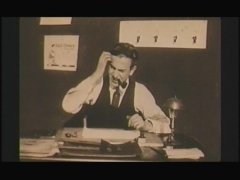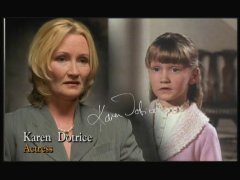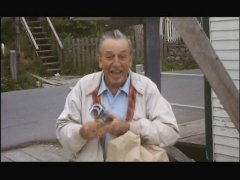Walt: The Man Behind the Myth documents the life and career of Walt Disney, an indivdual who single-handedly revolutionized animation, made ground-breaking cinematic innovations, and found general and critical success in a variety of entertainment endeavours. This two-hour feature opens with the highest point of Disney's career, the lavish premiere of the widely-praised Mary Poppins in 1964.
In many ways, Poppins was a culmination of Walt's achievements in family entertainment, calling to mind his earliest experiments at blending live action and animation and following forty years of innovation and ingenuity.
After this brief opening, The Man Behind the Myth returns to Walt's humble upbringing in midwestern America, covering his early taking to cinema and desire to partake in World War I (which led Disney to forge a document to appear old enough to participate). In the early 1920s, Walt ventured out west to Hollywood, with hopes of making a career in motion pictures. His earliest work in animation was a series of Laugh-o-Gram shorts - simple twists on familiar fables. From here, Walt went onto create a collection of "Alice comedies" centering on a young girl in a world of imagination. In these shorts, Walt blended live action (the young girl was played by a child actress) and animation (the background environment and surrounding elements), in a way different from the already-established way of combining live action backgrounds with animated characters.


The young Walt's first successful animated character, Oswald the Lucky Rabbit, wound up being stolen away by distributing executive Charles Mintz, a not uncommon procedure in these days. Following this bitter turn of events, Walt's next creation would make unprecedented leaps in worldwide popularity and longevity. Not only that, but Walt would make sure that he retained all rights to the character, a figure who remains as closely associated with Walt as any of his creations. It was named Mickey Mouse, and his debut in the 1928 short "Steamboat Willie" was noteworthy for being the first cartoon to employ synchronized audio of sound effects and dialogue.
From here, Walt would blaze an incomparable path in filmmaking. His 1932 short "Flowers and Trees" was the first animated piece to employ full color, part of an experimental contract with Technicolor that Walt agreed to.
"Flowers and Trees" was awarded the first Academy Award for Best Cartoon Short. Just five years later, Walt would again be the driving force behind another first, with the release of Snow White and the Seven Dwarfs, the first full-length animated film in America.
Though Walt: The Man Behind the Myth was produced and distributed by the studio that Disney himself launched and there undoubtedly exists enough to fill two hours of highlights and clips from Walt's life, this documentary is not satisfied to settle for that. Instead, through rare home video footage shot by Walt himself and a grand list of those who knew and worked with Disney, we see a "man of many faces" - an individual with a remarkable eye for innovation and the future, a relentless overseer of a studio of animators, a family man.
Of the animated feature films that probably today remain Walt's greatest and most beloved legacy, his earliest productions are given the most attention. The film is most particularly detailed in covering Snow White, Pinocchio, Fantasia, and Bambi. After this, Man Behind the Myth glazes over the anthology package features of the late '40s, giving only passing mention of Walt's goodwill flights to Latin America. Instead, we see an ugly period where Walt's animation staff went on strike. We even see Walt testify to the Committee on Un-American Activities, where he speaks out against communist behavior.


Even with his animated films providing him with distinct and uncontended success, Walt was not content to rest on his laurels. In the late '40s and early '50s, Disney began making live action films. The documentary provides some unique on-the-set footage of Song of the South, and proceeds to cover Walt's England production of Treasure Island and his 1954 epic sci-fi/adventure 20,000 Leagues Under the Sea. Disney's use of storyboards for planning live action camerawork remains widely used today.
Around the same time, Walt was finding still more success with the medium of television. His first special, "One Hour Wonderland", is seen in portion. Later in the '50s, the overwhelmingly popular "Davy Crockett" and the successful children's show "The Mickey Mouse Club" came from Disney. This paved way for Disney to host a series of episodes realizing a new dream that Walt had.
The dream was an amusement park for families to enjoy, unlike the seedy types of places that existed at the time. So came Disneyland and Walt reluctantly became the host to a series for ABC which documented the park's planning and creation. Right up to his death in 1966, Walt remained innovative. Having obtained prosperity and success in both animated and live action films, television, and a theme park, his next idea was to create a new "experimental prototype community that will always be in a state of becoming." This entertainment area Walt envisioned became Walt Disney World, which opened in Florida shortly after his passing.
Though undoubtedly a favorable documentary, Man Behind the Myth does portray Walt as human. Unwilling to dispatch praise and difficult to please, Walt is, nonetheless, seen as a great mind. His brilliant ideas and relentless efforts to create and put everything into his creation make him a unique and remarkable individual in the history of not just animation or film, but family entertainment at large.


VIDEO and AUDIO
Surely, a documentary like this cannot be evaluated the same way as a feature film. Of course, the video and audio quality of such a film likely won't make or break your decision to purchase it or not. Fortunately, I'm glad to report that the documentary exhibits fine video quality. Presented in 1.66:1 letterboxed widescreen, the newly-filmed footage is impeccably clean and rather sharp. The archival footage of classic films and home video is obviously a mixed bag. But the transfer of the film is praiseworthy, and it surely looks even better than its broadcast quality.
Presented in 2.0 Stereo Surround, the audio is completely suitable for the film. The interviews are all crisp and clear, and the old archival sound clips are also distinguishable and not requiring any kind of comment. The occassional music in the documentary does provide a bit of a soundfield, which is a nice advantage of a flat mono presentation entirely out of the front speaker. Overall, both video and audio are commendable.

BONUS MATERIAL
Bonus features are separated into seven sections, which each contain a variety of featurettes.
Most sections have the option to view the featurettes individually or consecutively through a "Play All" option.
An Intimate View (28 minutes) contains six featurettes containing additional clips of interviews with the individuals featured in the documentary. These are "Meeting Walt for the First Time" (4:40), "Walt as a Boss" (5:10), "Walt at Home" (3:50), "Walt and Music" (3:57), "Walt's Creativity" (4:57), and "Walt's Passing" (5:20). Family, friends, and employees share personal reflections of their experiences with Walt. Most of these clips could very well stand with the rest of the footage used in the film. They provide a more detailed and personal look at the man himself.
Disney Legends (32 minutes) profiles six prominent individuals who worked with Walt - Animator/Imagineer Marc Davis (4:55), Animators Ollie Johnston (5:34) and Frank Thomas (5:42), Artist/Storyman Joe Grant (4:52), animator Ward Kimball (5:34), and Arist/Imagineer John Hench (5:34).


In Actors, Directors & Friends (32 minutes), Dick Van Dyke (4:38), author Ray Bradbury (5:05), director Ken Annakin (4:58), director Richard Fleischer (6:22), Art Linkletter (5:41), and Dean Jones (5:13) are profiled, and discuss their interactions with Walt.
"The Making of Walt" is an 8-minute, 25-second featurette that discusses the making of the documentary. Walter Elias Disney Miller, the film's executive producer and Walt's grandson, talks about the timeliness of interviewing these people who worked with Walt before it's too late. The filmmakers also discuss their efforts to create the environment of a 1920s farm meant to look like Walt's home.
Location Visits discusses the locations and times that play a role in Walt's life. The locations are Chicago (Tripp Avenue and McKinley High School), Marceline, Kansas City (Bellefontaine, Benton School, and Laugh-O-Grams), and Los Angeles (Uncle Robert's House, Kingswell Studio, Lyric Houses, Hyperion Studio, Woking Way House, Burbank Studio, Holmby Hills House). All together, these run 10 minutes and serve as a nice supplement to the documentary, providing names, dates, and information about what the places are like today.


Home Movies contains clips from Walt's videos, with narration from his daughter Diane Disney Miller. She just basically describes what's going on and who's in the various shots. Altogether, they run only about five minutes, but they're wonderful glimpses into the fun-loving Walt, a different Walt than the one poised and professional in front of the TV cameras.
Last and least is a link to The Walt Disney Family Museum website, which claims to be "regularly updated" and "full of stories, essays, pictures and video" about Walt Disney.
The main menu is elegantly animated and all submenus play selections or clips from the score.

CLOSING THOUGHTS














